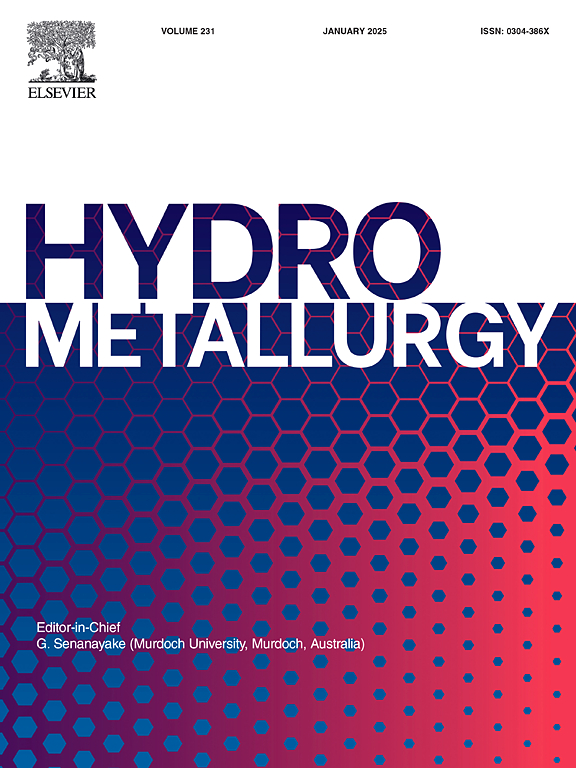Towards environmentally compatible in situ leaching of mine waste using low concentration acids
IF 4.8
2区 材料科学
Q1 METALLURGY & METALLURGICAL ENGINEERING
引用次数: 0
Abstract
Conventional mining of metalliferous rock typically involves physical excavation followed by mineral processing. These are energy intensive and environmentally invasive processes which produce large amounts of wastes. In situ leaching of mine wastes with acidic lixiviants may provide an opportunity to recover additional metals and decontaminate residual material. However, the use of high concentration mineral acids (such as >1 M sulfuric acid) can be harmful to the environment and may necessitate post treatment to remove the acidity from the residual rock. The feasibility of using less aggressive lixiviants that may mitigate these risks was explored; 0.1 M citric and sulfuric acid were applied as lixiviants to determine the leaching behaviour of As and Cu from legacy sulfidic Cu/As mine waste. This was achieved via triplicate column upflow tests with a cumulative liquid-solid ratio of 31. Citric acid was more efficient than sulfuric acid for As recovery, with recovery (leaching efficiency) rates of 40.7 wt% and 35.2 wt%, respectively, but slightly less effective for Cu recovery: 33.8 wt% and 43.2 wt% of the total content, respectively. The comparable performance, despite citric acid being a weaker acid, is attributed to its affinity to form soluble As/Cu-citrate complexes. Numerical modelling of heap leaching of the mine waste at field scale was undertaken to allow exploration of scenarios for metal recovery versus time, lixiviant application rate and reagent consumption. This study highlights the suitability of applying lixiviants for the in situ leaching of metals from mine waste in low concentrations over a prolonged timescale. The work therefore provides a step towards unlocking a new paradigm of metal recovery and remediation for modern and legacy mine wastes with minimal environmental disturbance and energy input.
采用低浓度酸对矿山废物进行环境相容的原位浸出
传统的含金属岩石开采通常包括物理开挖,然后是矿物加工。这些都是能源密集型和对环境有害的过程,产生大量废物。用酸性浸出剂对矿山废物进行就地浸出,可以提供一个机会来回收额外的金属和净化残留物质。然而,使用高浓度的矿物酸(如1m硫酸)可能对环境有害,可能需要后处理以去除残留岩石中的酸性。研究人员探讨了使用较低侵蚀性的清洗剂以减轻这些风险的可行性;采用0.1 M柠檬酸和硫酸作为浸出剂,研究了铜/砷矿渣中砷和铜的浸出行为。这是通过累积液固比为31的三次柱向上流动试验实现的。柠檬酸比硫酸更有效地回收砷,回收率(浸出效率)分别为40.7%和35.2%,但对铜的回收率略低,分别为33.8%和43.2%。尽管柠檬酸是一种较弱的酸,但其相当的性能归因于其形成可溶性As/ cu -柠檬酸配合物的亲和力。在现场规模上对矿山废物的堆浸进行了数值模拟,以便探索金属回收率随时间、浸出剂用量和试剂消耗量的变化情况。这项研究强调了使用浸出剂在长时间内从矿山废物中低浓度地浸出金属的适宜性。因此,这项工作为以最小的环境干扰和能源投入开启现代和传统矿山废物的金属回收和补救新范例提供了一步。
本文章由计算机程序翻译,如有差异,请以英文原文为准。
求助全文
约1分钟内获得全文
求助全文
来源期刊

Hydrometallurgy
工程技术-冶金工程
CiteScore
9.50
自引率
6.40%
发文量
144
审稿时长
3.4 months
期刊介绍:
Hydrometallurgy aims to compile studies on novel processes, process design, chemistry, modelling, control, economics and interfaces between unit operations, and to provide a forum for discussions on case histories and operational difficulties.
Topics covered include: leaching of metal values by chemical reagents or bacterial action at ambient or elevated pressures and temperatures; separation of solids from leach liquors; removal of impurities and recovery of metal values by precipitation, ion exchange, solvent extraction, gaseous reduction, cementation, electro-winning and electro-refining; pre-treatment of ores by roasting or chemical treatments such as halogenation or reduction; recycling of reagents and treatment of effluents.
 求助内容:
求助内容: 应助结果提醒方式:
应助结果提醒方式:


